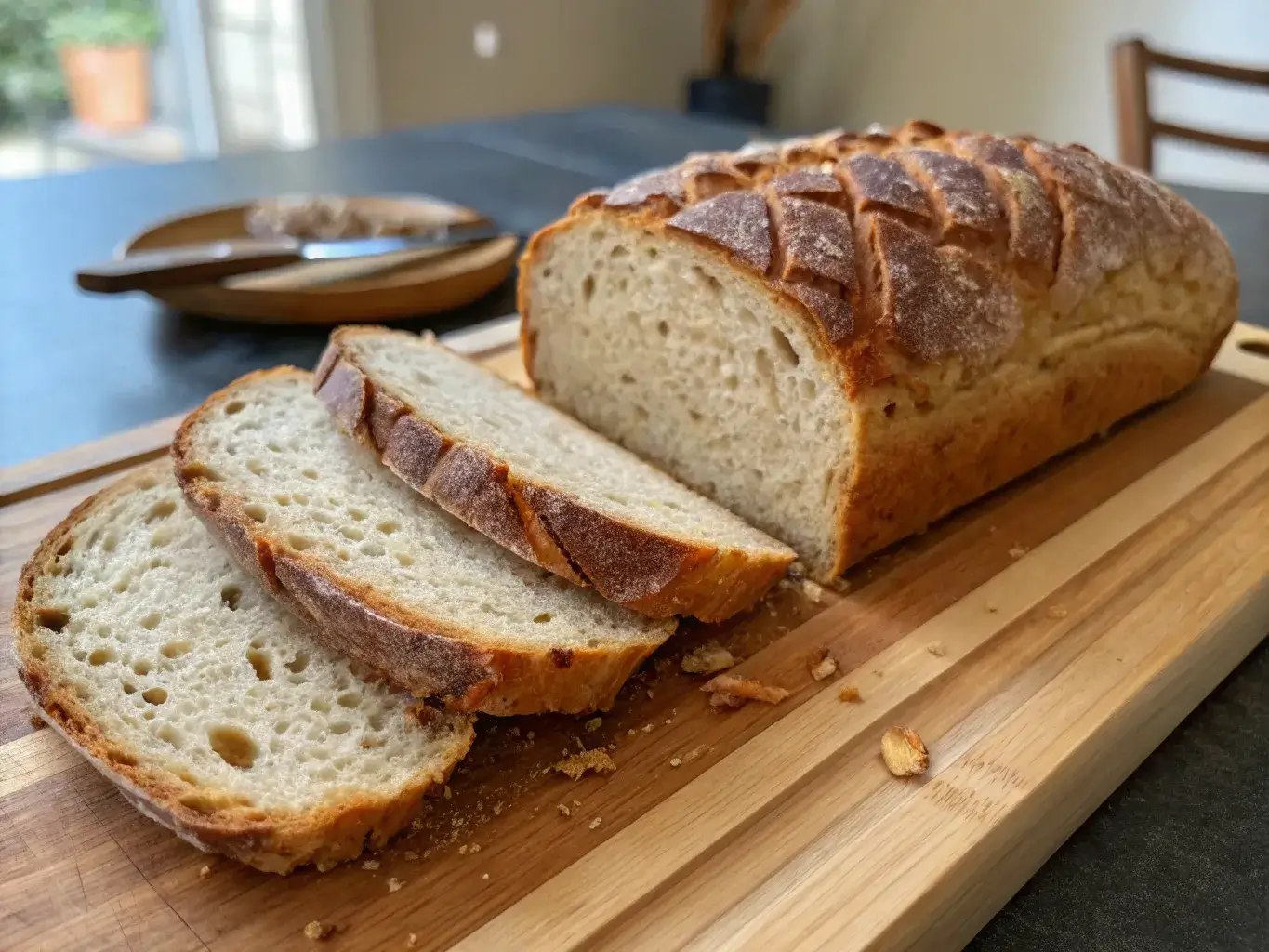Protein sourdough bread is becoming a favorite among health-conscious bakers who want the rich flavor of sourdough with the added benefit of higher protein. Whether you’re aiming for better satiety, muscle recovery, or just a more nourishing loaf, learning how to bake and enjoy protein-rich sourdough can be a game-changer.
In this guide, we’ll explore how much protein is in sourdough, ways to boost its protein content, and the best techniques for baking a loaf that’s both healthy and delicious.
Understanding Protein in Sourdough Bread
Is Sourdough Bread High in Protein?
Compared to standard white bread, protein sourdough bread often contains more protein, especially when made with whole wheat, bolted flour, or enriched with seeds and nuts. While sourdough itself doesn’t magically add protein, the fermentation process makes nutrients more bioavailable, allowing your body to better absorb the protein that’s already present in the flour.
Why Protein Matters in Bread Baking
Protein is key to both nutrition and texture. In sourdough, the gluten network formed by proteins in wheat creates structure and helps the bread rise. Higher protein flour results in dough that’s more elastic, easier to handle, and capable of producing the airy crumb that bakers love.
Nutritionally, more protein means better satiety, support for muscle recovery, and steady energy levels. That’s why many people prefer protein sourdough bread over traditional white bread.
Protein in Sourdough vs. Regular Bread
The fermentation in sourdough not only makes protein easier to digest but may also slightly improve the bread’s nutritional value compared to regular yeasted bread. While the protein content per slice may not differ drastically, sourdough is often made with more nutritious flours like whole wheat or high-extraction (bolted) flour, boosting the protein content naturally.
Here’s a quick comparison:
| Bread Type | Protein per Slice | Digestibility | Flavor Profile |
|---|---|---|---|
| White Bread | ~2–3g | Lower | Mild |
| Whole Wheat Bread | ~3–4g | Moderate | Nutty, earthy |
| Protein Sourdough | ~4–6g | Higher | Tangy, complex |

Protein Sourdough Bread: The Complete Guide for Nutritious Baking
- Total Time: 12 hours 45 minutes
- Yield: 1 loaf 1x
- Diet: Vegetarian
Description
A hearty, chewy sourdough bread boosted with protein powder and seeds—perfect for fitness enthusiasts who want extra nutrition without sacrificing flavor.
Ingredients
400g bread flour
100g whole wheat flour
50g unflavored whey protein powder or plant protein powder
350g water (room temperature)
100g active sourdough starter (100% hydration)
10g salt
30g sunflower seeds
20g chia seeds
20g flaxseeds
Instructions
1. In a large bowl, mix bread flour, whole wheat flour, protein powder, and water until no dry spots remain. Cover and rest for 30 minutes (autolyse).
2. Add the sourdough starter and mix well. Sprinkle in salt and knead until incorporated.
3. During the first 2 hours of bulk fermentation, perform 3–4 sets of stretch and folds every 30 minutes. Add sunflower, chia, and flaxseeds during the second fold.
4. Let dough bulk ferment at room temperature (around 75°F/24°C) for 4–5 hours, or until it has risen 50% and feels airy.
5. Turn dough onto a lightly floured surface and pre-shape into a round. Rest for 20 minutes.
6. Shape into a boule or batard and place seam-side up in a floured proofing basket.
7. Cover and refrigerate overnight (8–12 hours).
8. Preheat oven to 475°F (245°C) with a Dutch oven inside.
9. Transfer dough to parchment paper, score the top, and place into the hot Dutch oven.
10. Bake covered for 20 minutes, then uncover and bake for another 20–25 minutes until deep golden brown.
11. Cool on a wire rack for at least 1 hour before slicing.
Notes
Use unflavored protein powder to avoid altering the bread’s taste.
Seeds add extra protein, fiber, and healthy fats—feel free to swap or add pumpkin or hemp seeds.
Hydration may need adjusting slightly depending on the protein powder used.
This bread is excellent for sandwiches, toast, or post-workout fuel.
- Prep Time: 12 hours
- Cook Time: 45 minutes
- Category: Bread
- Method: Baking
- Cuisine: Rustic
Nutrition
- Serving Size: 1 slice
- Calories: 170
- Sugar: 1g
- Sodium: 200mg
- Fat: 3g
- Saturated Fat: 0.5g
- Unsaturated Fat: 2g
- Trans Fat: 0g
- Carbohydrates: 29g
- Fiber: 3g
- Protein: 8g
- Cholesterol: 0mg
Keywords: protein sourdough bread, high protein bread, sourdough with seeds, fitness bread
How Much Protein Is in a Slice of Sourdough Bread
Average Protein Content per Slice
A typical slice of protein sourdough bread contains between 4–6 grams of protein, depending on the type of flour used and any added ingredients. This is higher than standard white bread, which usually has around 2–3 grams per slice. By using high-protein flours or adding seeds and nuts, bakers can easily push the protein content even higher.
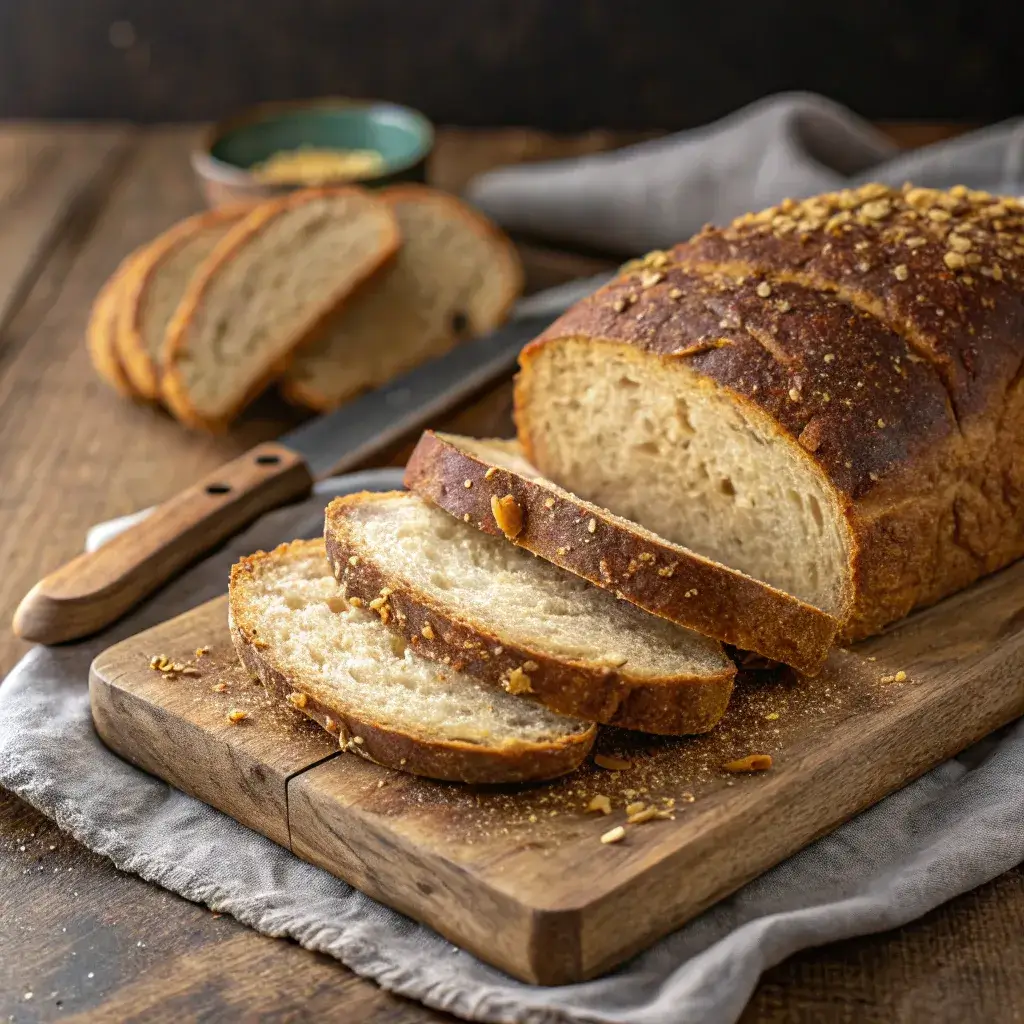
Factors That Influence Protein Levels
Several factors influence the protein content of your sourdough:
- Type of Flour: Whole wheat and bolted flour naturally provide more protein than refined white flour.
- Add-ins: Seeds, nuts, and legumes boost protein density.
- Use of Vital Wheat Gluten: Adding this ingredient strengthens the dough and raises protein content.
- Serving Size: Thick slices naturally contain more protein than thin slices.
Comparison Table: White, Whole Wheat, and Protein Sourdough
| Bread Type | Average Protein per Slice | Extra Protein Sources |
|---|---|---|
| White Bread | 2–3g | None |
| Whole Wheat Bread | 3–4g | Bran and germ |
| Protein Sourdough | 4–6g | Seeds, nuts, gluten |
For bakers looking to meet nutritional goals, protein sourdough bread offers a satisfying way to get more protein without giving up the comfort of fresh, homemade bread.
What Bread Has the Most Protein?
High-Protein Bread Types Explained
When it comes to protein content, not all breads are created equal. While standard white loaves are on the lower end, options like protein sourdough bread, sprouted grain bread, and loaves enriched with seeds pack more nutritional power. These breads combine high-protein flours with fermentation or added ingredients to raise the total protein per slice.
Sourdough vs. Sprouted Grain Bread
Sprouted grain breads are known for their higher protein content because sprouting makes nutrients more available. However, protein sourdough bread can be just as nutritious, especially when made with whole grains, bolted flour, or vital wheat gluten. Sourdough’s fermentation process further boosts digestibility, making the protein easier for your body to absorb.
Bolted Flour and High-Protein Baking
Bolted flour plays a unique role in creating protein sourdough bread. It retains much of the wheat germ and bran, both of which are rich in protein and minerals, while still producing a loaf that’s lighter and easier to handle than 100% whole wheat. Combining bolted flour with seeds such as sunflower, pumpkin, or chia is an easy way to bake bread that rivals even the highest-protein store-bought loaves.
| Bread Type | Protein per Slice | Digestibility | Texture |
|---|---|---|---|
| White Bread | 2–3g | Low | Very soft |
| Sprouted Grain Bread | 5–7g | High | Dense, hearty |
| Protein Sourdough | 4–6g | Very High | Light, rustic |
If you’re looking for the best balance of taste, texture, and nutrition, protein sourdough bread stands out as a top contender.
Ingredients That Boost Protein in Sourdough
Using High-Protein Flour
The type of flour you choose makes a huge difference in protein sourdough bread. High-protein flours like bread flour, whole wheat, and bolted flour naturally raise protein content while providing the gluten strength needed for structure. Bolted flour is especially useful since it keeps much of the wheat germ and bran, offering both nutrition and a lighter crumb.
Adding Seeds, Nuts, and Legumes
Seeds and nuts are excellent ways to boost the protein profile of sourdough. Common options include:
- Sunflower seeds (6g protein per ounce)
- Pumpkin seeds (7g protein per ounce)
- Chia seeds (5g protein per ounce)
- Walnuts or almonds (4–6g protein per ounce)
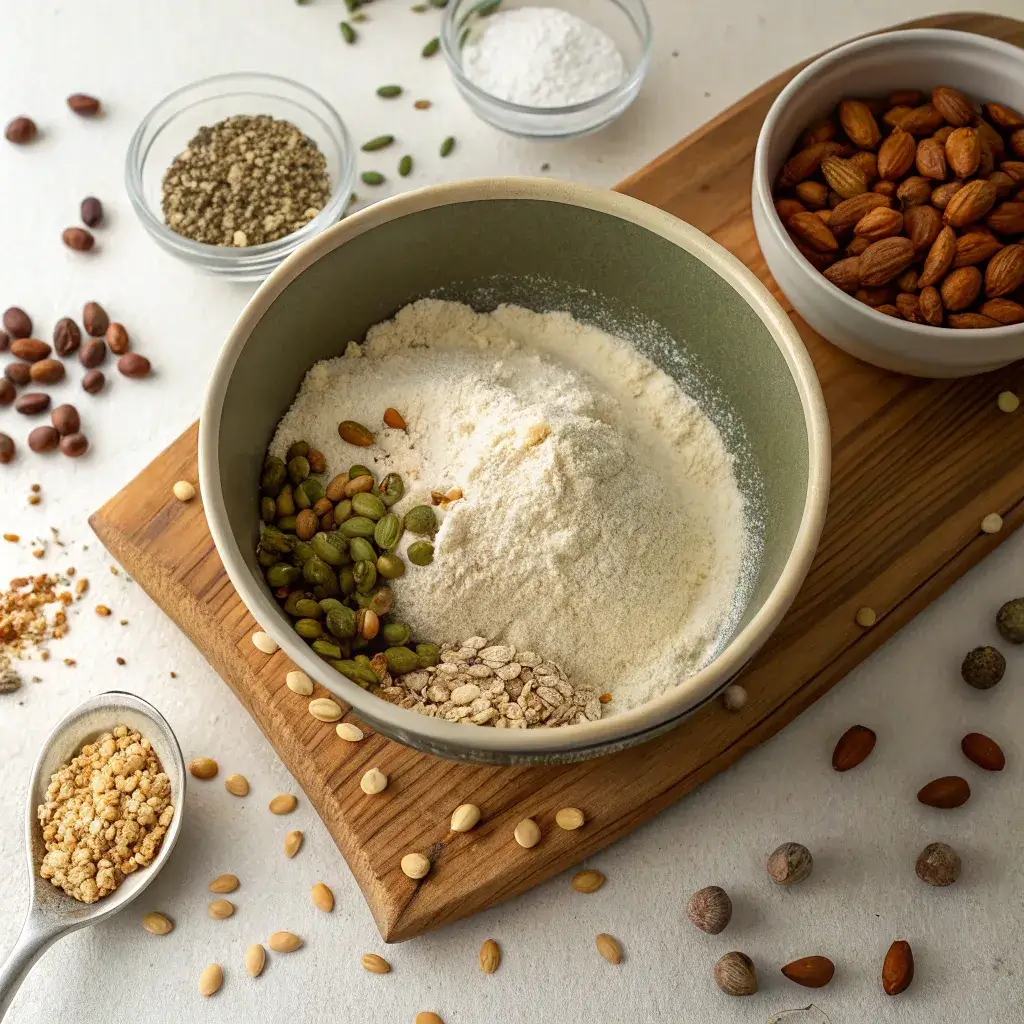
These not only add protein but also introduce healthy fats and crunch, enhancing both nutrition and flavor in protein sourdough bread.
Role of Vital Wheat Gluten
Vital wheat gluten is a concentrated source of gluten protein. Adding a small amount, usually 2–4 tablespoons per loaf, significantly improves dough elasticity and increases protein content. For bakers who want the highest rise and crumb structure in their protein sourdough bread, this ingredient can be a valuable addition.
How to Add Protein to Your Sourdough Bread
Recipe Adjustments for More Protein
Boosting the protein content of protein sourdough bread starts with choosing the right ingredients. Replace some white flour with whole wheat or bolted flour for a natural protein increase. You can also add a scoop of vital wheat gluten to boost protein levels and strengthen the dough.
How Can I Add Protein to My Sourdough Bread?
Here are simple strategies:
- Use High-Protein Flour: Choose bread flour or a blend of bolted and whole wheat flour.
- Add Seeds and Nuts: Mix in pumpkin seeds, sunflower seeds, or almonds.
- Incorporate Legume Flours: Small amounts of chickpea or lentil flour can lift protein.
- Use Greek Yogurt or Milk: For soft sourdough rolls, dairy boosts both protein and tenderness.
Balancing Protein and Hydration
When adding protein-rich ingredients, dough hydration often needs adjusting. Seeds and nuts absorb water, so increase hydration slightly to keep the dough supple. For example, if your base recipe uses 75% hydration, bump it up to 77–78% when adding a cup of seeds. This ensures your protein sourdough bread stays soft without becoming dense.
Baking Techniques for Protein-Rich Sourdough
Mixing and Kneading for Gluten Development
More protein means more gluten potential, but only if it’s developed correctly. In protein sourdough bread, thorough mixing and proper stretch-and-fold cycles build a strong gluten network, helping the dough trap gases and rise beautifully.
Adjusting Hydration for High-Protein Recipes
Protein-rich doughs often require more hydration because high-protein flours absorb more water. Aim for 75–78% hydration when baking with whole wheat or bolted flour. Watch the dough’s feel: it should be elastic and slightly tacky but not overly sticky.
Proofing and Oven Spring Considerations
Because high-protein dough tends to be more elastic, proofing may take slightly longer. Focus on the dough’s volume increase rather than the clock to judge readiness. Well-proofed protein sourdough bread will show steady oven spring and develop a strong crust without tearing.
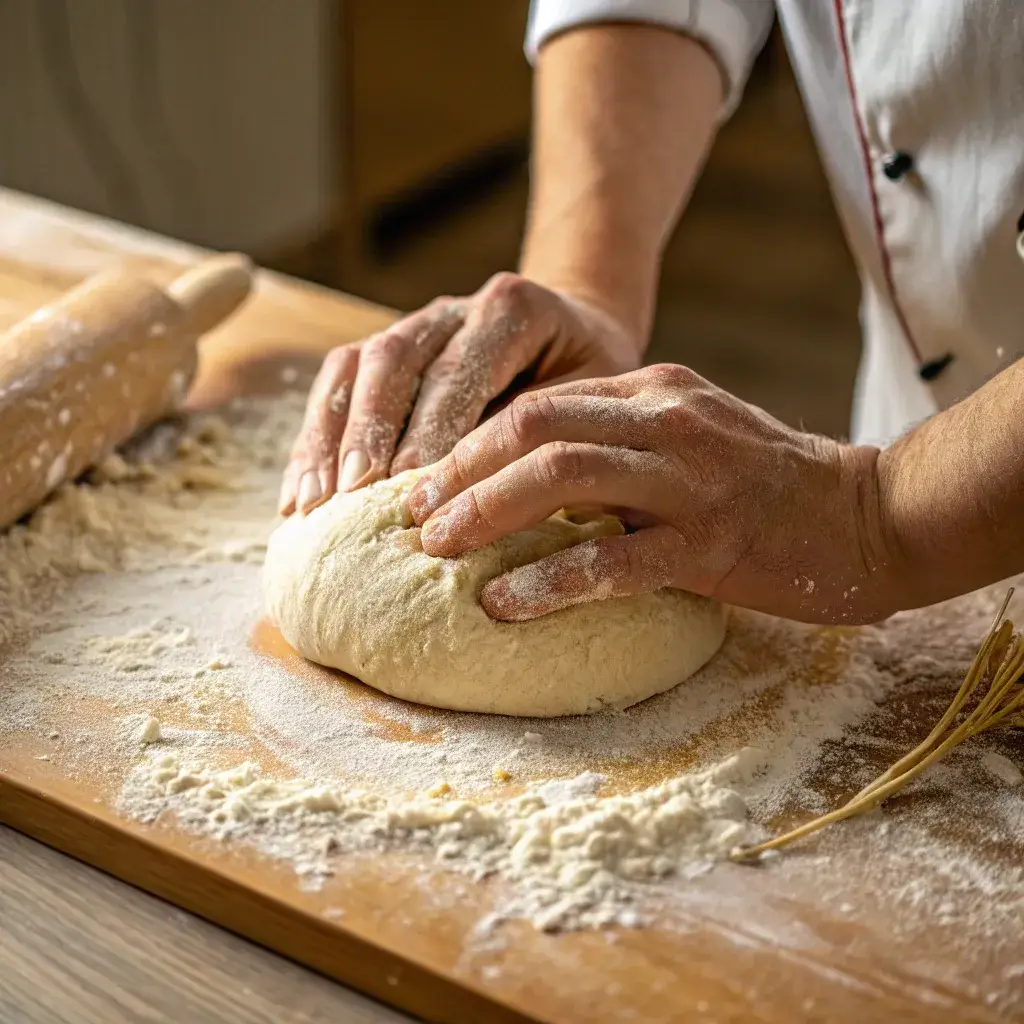
Nutrition Benefits of Protein Sourdough Bread
Protein and Satiety
One of the biggest perks of protein sourdough bread is its ability to keep you fuller longer. Protein slows digestion, reducing hunger cravings and supporting healthy weight management.
Muscle Recovery and Energy Support
For active individuals, the protein in sourdough helps repair muscles and maintain energy throughout the day. Pairing sourdough with nut butter, cheese, or eggs turns a slice into a balanced post-workout snack.
Comparing Protein Bread to Store-Bought Options
Unlike many commercial “protein breads” that rely on additives, homemade protein sourdough bread provides natural, clean ingredients. You control the flour, hydration, and protein sources, ensuring every slice is both nutritious and flavorful.
| Bread Type | Protein (per slice) | Additives? | Flavor Quality |
|---|---|---|---|
| Store-Bought White | 2–3g | Often yes | Mild |
| Commercial Protein Bread | 7–9g | Yes | Dense |
| Homemade Protein Sourdough | 4–6g | No | Rich, tangy |
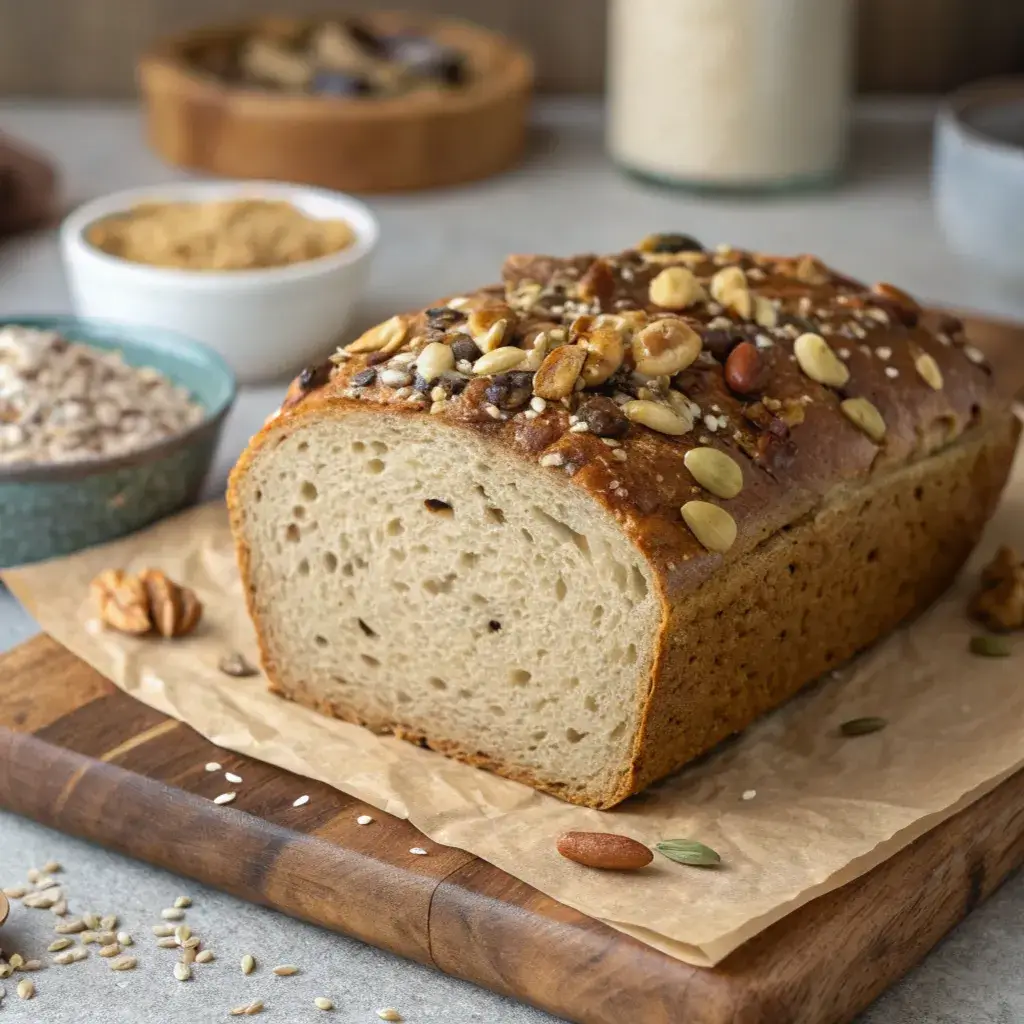
Common Mistakes and Fixes in Protein Sourdough
Overloading with Protein Additives
It may be tempting to add too much vital wheat gluten or legume flour, but in protein sourdough bread, excess protein can make the dough tough and rubbery. Limit your addition of vital wheat gluten to 2–4 tablespoons per loaf. This enhances protein and dough strength without compromising the crumb’s texture.
Hydration Issues with Extra Protein
High-protein ingredients like seeds and whole grains absorb more water. If you don’t adjust the hydration, the dough may become stiff and dry. Always increase hydration slightly, usually by 2–3% to maintain a supple dough.
Avoiding Dense, Heavy Loaves
Dense loaves are a common issue when baking protein sourdough bread. To prevent this:
- Don’t skip stretch-and-folds (they strengthen gluten).
- Avoid overproofing (use the finger poke test).
- Bake in a preheated Dutch oven to achieve maximum oven spring.
FAQ About Protein in Sourdough Bread
Is sourdough bread high in protein?
Yes, especially when made with whole wheat or bolted flour. On average, each slice of protein sourdough bread provides 4–6 grams of protein.
How much protein is in a slice of sourdough bread?
The protein content varies by recipe, but most slices of protein sourdough bread provide around 5 grams, compared to 2–3 grams in standard white bread.
What bread has the most protein?
Sprouted grain bread and protein sourdough bread usually have the highest protein. Adding seeds or vital wheat gluten can raise levels even more.
How can I add protein to my sourdough bread?
Use high-protein flour, add seeds and nuts, or mix in a small amount of vital wheat gluten. These methods increase the protein content of protein sourdough bread without sacrificing texture.
Mastering Protein Sourdough Bread for Health and Flavor
Baking protein sourdough bread gives you the best of both worlds: the tangy, rustic flavor of sourdough and the added nutrition of high-protein ingredients. By choosing the right flour, balancing hydration, and practicing solid baking techniques, you’ll enjoy loaves that are flavorful, filling, and nourishing. Whether you’re an athlete, health-conscious eater, or just a bread lover, protein-packed sourdough can be a delicious staple in your kitchen.

